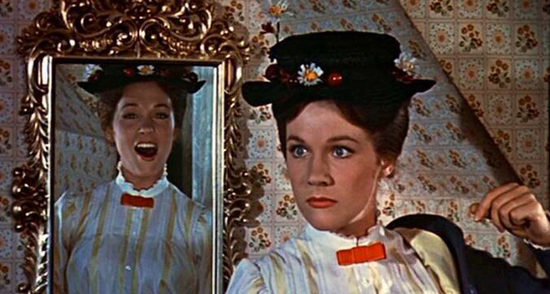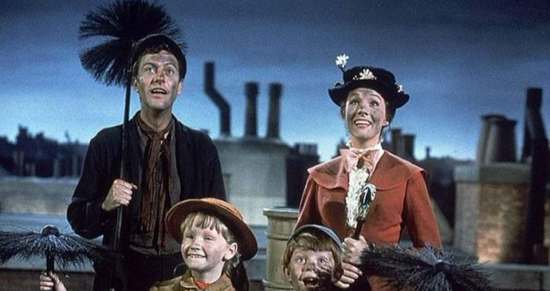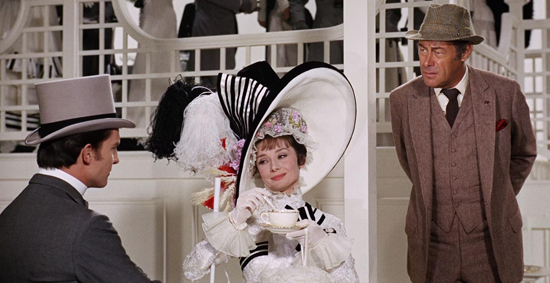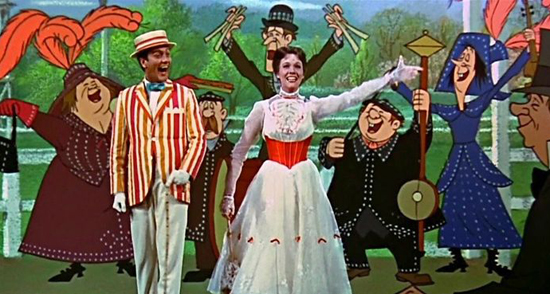
Whenever I spotlight movies with similar plots and thematic elements in this series, it’s usually a competition between movies that are indirect competition, whose standing as a movie doesn’t necessarily need to be defined with it’s comparison to another. But there are instances in Hollywood history where movies were indeed made to compete against one another, and in some cases, the behind the scenes story of these competitions becomes just as intriguing as the movies themselves. Such was the case with the year 1964, when the big budget movie musical saw a brief revival in the early part of that decade and hit a high point when two studios actively jumped in and took shots at placing itself atop with their own additions to the genre. Surprising to many is that this cutthroat competition at the box office involves two musicals with the unlikeliest of settings to appeal to a broad American audience; that being turn of the century Edwardian England. The two movies in question were of course the Broadway to Hollywood transplant that was Warner Brothers’ My Fair Lady (1964) and the cinematic original Mary Poppins (1964) from Walt Disney Productions. Today, these two movies are quaint, audience pleasing relics of a bygone era in old Hollywood, but it may surprise many that behind the scenes, these movies involved a back and forth war between two studio giants that saw the making and breaking of creative partnerships between the executives and the talent involved. Despite the turmoil behind the scenes, the movies still became huge successes for both parties, and both remain perennial favorites for cinephiles everywhere. But based on their weaknesses and strengths, it is interesting looking at how they stack up together, especially considering their shared history. So, let’s take that jolly holiday back to Golden Age Hollywood and see which lady remains the fairer.
First off it is interesting looking how these two movies came into being in the first place. My Fair Lady had previously started on the Broadway stage in 1958, with music and lyrics by the team of Lerner & Lowe, the same people who turned Camelot into a massive hit on the stage a couple years prior. The musical itself was based on the famous play Pygmalion by English playwright George Bernard Shaw, which itself was inspired by the Greek myth of the same name. The musical added songs, but still retained the core plot, characters and whit of Shaw’s original piece. Lady of course was a smash hit and Hollywood took notice immediately. Warner Brothers won out in a bidding war with other studios and began development immediately on a screen adaptation. Unfortunately for them, the movie languished for a while as it became harder and harder to fill the different roles with actors that would fit. In the end, it was decided that the original Broadway cast would be carried over, except for one notable exclusion; the original Eliza Doolittle, Julie Andrews. According to historians, Andrews was passed over because Warner Brothers’ head Jack Warner didn’t view her as a big enough name to carry a movie this size. Rex Harrison, the other lead in the musical playing Professor Henry Higgins, was just coming off a major role as Julius Ceaser in Fox’s Cleopatra (1963), which shielded him from the same scrutiny, so unfortunately for Ms. Andrews, who had yet to make the jump from stage to screen was denied her shot, despite the rave reviews she had earned before in the role. Jack Warner instead turned to Oscar-winning screen legend Audrey Hepburn for the role of Eliza, which turned a few heads in the industry because Hepburn did not have a musical background. She had sung on screen before, including the song “Moonriver” in Breakfast at Tiffany’s (1961), but that was a far cry from what she was going to undertake as Eliza Doolittle, which is not an easy role. And indeed, even Jack Warner began to have second thoughts, even after passing over Julie for Audrey. He made the controversial decision to dub over all of Audrey’s singing tracks with an uncredited vocalist named Marni Nixon, who had previously done dub work for Deborah Kerr in The King and I (1956). Unfortunately, the news of this replacement broke through and became a scandal of it’s own, which sadly reflected back on Audrey Hepburn and damaged her reputation as a vocalist on screen for some time after.

“In every job that must be done, there is an element of fun. You find the fun, and snap…the job’s a game.”
Meanwhile, Disney was in the midst of it’s own tumultuous development of a big screen musical. Instead of taking a known property from the stage, Walt Disney and company set out to create one from scratch, adapting a well known children’s book series to screen. This two languished on for years, as Walt Disney had to contend with Mary Poppins’ notoriously stubborn original author P. L. Travers in order to secure the rights. The back and forth with Ms. Travers itself inspired it’s own movie called Saving Mr. Banks (2013), starring Emma Thompson as Travers and Tom Hanks as Disney. Walt did eventually get Travers on board, though just barely, and set out to make Mary Poppins the culmination of all his cinematic prowess that he had gained up to this point. With a collection of catchy songs by the Sherman Brothers and top notch talent assembled from across the studio, Disney had the movie ready to roll. There was only one issue left; who would play Mary? As it turned out, Walt had a gift land right into his lap as Warner Brothers discarded one of the top tier Broadway talents off of their My Fair Lady adaptation, and she was suddenly available. Walt, who was also a fan of Broadway, had been trying to sway Julie Andrews over to his studio ever since her introduction in Camelot, and not one to miss an opportunity, he took full advantage of Jack Warner’s misstep. Julie Andrews was offered the role of Mary Poppins without ever auditioning, and she gladly accepted the part on the spot. With their Mary in place, Disney’s production went into full swing, just as Warner Brothers was deep into production with their Andrews-less My Fair Lady. With high expectations for both, they entered cinemas months apart, Poppins first in the summer and then Lady in the late fall, and were both immediate smash hits. Indeed, their competition lasted long into the next year and gave a huge boost to the then flailing movie musical genre. This extended well into Oscar Season, where My Fair Lady came out on top with the Best Picture honor, but Julie Andrews (the one Jack Warner thought was not ready for the movies) earning Best Actress, in a race where Audrey Hepburn had been completely shut out of.

“The rain in Spain stays mainly on the plain.”
It might be easy to view this as a case of Audrey Hepburn being horribly miscast in the role of Eliza Doolittle, but that entirely not true at all. Audrey’s performance in My Fair Lady is actually quite strong and divorced from all the controversy surrounding her casting in this film, one could look at this movie and believe rightly that Audrey Hepburn is actually perfectly cast in the part. It’s Warner Brothers, and Jack Warner in particular, who are responsible for shaping the controversial reputation of her role in the film with their terrible mismanagement of the back stage drama that unfolded. When she’s onscreen, Audrey is magnetic. She brings an infectious energy to the role, does surprisingly well with Eliza’s cockney accent in the early part of the movie, and just looks flat out amazing in the lavish dresses. In many ways, the reason why her performance falters in the overall movie is not her fault at all. It’s an incomplete performance, made all the more noticeable by the fact that Marni Nixon’s melodic voice is so different than her own. Nixon has a thoroughly stage trained voice meant to invoke power, whereas Hepburn’s singing voice comes from a more earthbound place. That’s not to say they couldn’t make Hepburn’s more natural tones work for the role. Over the years snippets of Hepburn’s real vocal tracks have emerged and they prove that she indeed had the vocal range to deliver in this role, but sadly we get the mismatch that occurs in the final film, and it is a negative reflection on the film. No inconsistencies exist in Mary Poppins on the other side. Walt knew fully well of the gift he was granted with the angelic voice of Julie Andrews it is used to the fullest in Poppins. From “Spoon Full of Sugar” to “Supercalifragilisticexpialidocious” to “Feed the Birds”, Julie’s Mary imbues the movie with unimaginable grace, and her Mary remains to this day one of the most beloved movie heroines of all time. Not only that, but Julie also shows a maturity in front of the camera that you wouldn’t expect from a Hollywood novice, and it immediately brought her fully off the stage and onto the screen. And yes, Jack Warner realized this as well, only after it was too late.
But, My Fair Lady does have many elements that make it stand out strong in comparison to it’s competitor, and in some ways is even superior in comparison. One is the story itself. Mary Poppins is a thoroughly entertaining piece of cinema on the whole, but one nitpick that someone might make about it is that it’s light on story. Mary Poppins, a magical nanny, swoops into the lives of the Banks family and through a series of extraordinary events, manages to repair their fractured relationship before leaving to return to wherever she came from. It’s the nature of adapting a narrative from a episodic series like the original Poppins books that the movie itself would take on an episodic structure. That’s essentially what we get in Mary Poppins. It’s a movie with interconnected adventures loosely tied together, and as great as those individual adventures are, they really don’t have much bearing on the overall story. Much of the narrative drive of Mary Poppins is not focused her, nor the Banks children but instead on George Banks, the father (played superbly by David Tomlinson) who’s the only character with an arc in the movie. Mary Poppins, throughout the entire movie, remains mostly an enigma, providing instigation to the plot rather than any active participation. By comparison, the character arcs in My Fair Lady are far more layered and intriguing. Taking it’s cue from George Bernard Shaw, Lady has much more bite to it than Mary Poppins. It takes the risk of introducing it’s characters in a not so flattering light upfront, with Eliza Doolittle introduced being a brash, unsophisticated street vendor and Henry Higgins introduced as a misogynistic high class jerk who looks down on the poor. It’s a story about transformation, as Eliza goes from Cockney to classy, and in turn she forces a change in Higgins where he begins to learn the error of his ways and softens his brash façade. A tried old tale of a selfish man believing that he can craft the perfect woman, only to find that a perfect woman is one that doesn’t need him in order to feel complete, and him in turn forced to change his ways to prove his own worth. Shaw reinvisioned it for his own time in Pygmalion, and the musical perfectly carries that forward through song, and you can see the same story play out in more a modern reimagining like Pretty Woman (1990) and She’s All That (1999). Overall, it’s what gives My Fair Lady extra cinematic weight over the more airy Mary Poppins.

“Winds in the east, mist coming in. Like somethin’ is brewin’ and ’bout to begin. Can’t put my finger on what lies in store, but I feel what’s to happen all happened before.”
Another thing that My Fair Lady has over Poppins is a more commanding second lead. Much has been said about the controversial choice of casting Dick Van Dyke as a cockney voiced chimney sweep in Edwardian London. True, Dick Van Dyke is a national treasure and a still living legend as of this writing, and his presence in Mary Poppins is a welcome one, especially in the musical numbers where he excels. However, the accent is notoriously bad, as the all-American star of stage and screen finds it well out of his range to convince us he’s a Cockney. Compared to his co-star whose Englishness is gracefully on display through the whole movie, he definitely looks a bit out of place, though his chemistry with Julie is strong. In My Fair Lady, we get Rex Harrison at the height of his power as a performer. In a sense, this was a difficult role to undertake, as Henry Higgins is not an easy character to like. With such a backwards, toxic view of the opposite sex, how are we ever to believe that Henry Higgins can be a worthwhile romantic foil for Eliza Doolittle by the end of the movie. Somehow, Rex Harrison manages to balance all that perfectly in his performance. His delightfully salty insults carry this edge of ridiculousness that helps to soften the blow and make the character intriguing to the audience. Only an actor with the kind of presence as Rex Harrison could believably pull this off, because if you were to say the things that Henry Higgins says to Eliza in the movie outside of context in the real world, you’re probably opening yourself up for a workplace harassment suit. An interesting side note about Harrison’s performance in the film is that he refused to do a dub track for himself. As a veteran stage actor, he was used to delivering a different level of performance with every show, and he wanted to maintain that even in the movie. If they pre-recorded his voice, it wouldn’t match what he was giving them in front of the camera. So, unlike his fellow actors, he had his vocal tracks recorded live on the set instead of in a separate booth later. If you look closely in the movie, there are hidden mics sewn into his costumes, such as a tie or a corsage pinned to his suit, just so they could capture his singing in the moment.
One of the things that both movies actually illustrate brilliantly together is the level of production design that went into making them. Despite the fact that both movies are set in Edwardian London during the early part of the 20th century, it will amaze many to know that both movies were actually shot entirely in sunny Burbank, California and completely indoors on soundstages at their respective studio lots. In fact, it’s quite possible that both movies were shooting simultaneously within only a mile distance from one another; I know, I’ve walked that actual distance between the studios, it can be done in less than 15 minutes (depending on the timing of the crosswalks). It’s amazing how both films are still able to convey an authentic sense of time and place even under these conditions. You never question the fact that you’re looking at studio built sets that invoke the feeling of the outdoors. In some cases, they really pulled out all stops to convey authenticity, like the Ascot Gavotte sequence in My Fair Lady, where the crew actually had real race horses gallop at full speed across the different ends of the stage to make it feel like the characters were at a real track. Still, there are several moments in My Fair Lady where it’s hard to shake off the stage bound origins it derives from. It’s a very interior heavy film, and a lot of the movie is set within people’s homes and far fewer set out in the open streets. Mary Poppins on the other hand expands far beyond the limits of the soundstage. Spends much more of it’s time outside, which feels authentic and detailed even though it’s all still in a soundstage. With a combination of brilliant set design, plus exquisitely detailed matte paintings done by the legendary Peter Ellenshaw, Mary Poppins gives you a more fully enriched and alive London, which feels remarkably real to the viewer. The movie even broke ground by placing it’s actors in an animated world (Disney’s strong suit) in a still impressive to this day visual effect. Though My Fair Lady has top notch production values, Mary Poppins on the whole is the movie that takes the most advantage of it’s cinematic options and in general feels the most alive. When you can convince an audience that they are indeed in cold, damp London, England and not in a scorching hot soundstage in Burbank, California, you know you’ve done right.

“The difference between a lady and a flower girl is not how she behaves, but how she is treated.”
In the end, audiences were blessed with two classics that have indeed withstood the test of time to remain cinematic favorites to this day. Indeed, for some it’s hard to choose one over the other, because they are both so brilliantly crafted and offer different experiences. The one thing that binds them together is the fact that one movie benefitted from the callous oversight of the other and created this fascinating “what if” scenario that cinephiles have speculated over. How different would things have been had Jack Warner not shunned Julie Andrews and allowed her to play the role she had created for the stage originally? Would Mary Poppins have been the masterpiece that it is had someone else filled Andrews place in the role? Would Audrey Hepburn have escaped that unfortunate cloud of controversy that would leave a mark on her otherwise flawless career? Certainly in the end Julie Andrews got the last laugh. Upon receiving a Golden Globe win before her inevitable Oscar, she thanked in her speech the man responsible for making it happen, Mr. Jack Warner, in a not so subtle dig at the man who thought she was not ready for the big screen. It is indeed unthinkable to imagine anyone else in the original role of Mary Poppins than Julie Andrews, and it was a stroke of great timing on Walt Disney’s part to bring her on board the moment she was available. And of course she would carry that on into an even bigger role as Maria von Trapp in the juggernaut that was The Sound of Music (1965) a year later. One thing that I hope no one overlooks is that Audrey Hepburn was not an inferior replacement; she was a great Eliza Doolittle in her own right. I think taken on that alone most audiences today will recognize that she is indeed one of the things that makes My Fair Lady a continuing classic to this day. Mary Poppins is indeed the more ambitious of the two, but My Fair Lady holds it’s own with impressive production values and great performances to it’s credit as well. It’s a close call competition that leaves a stellar legacy for both productions that are both “loverly” and “practically perfect in every way.”

“It’s a Jolly Holiday with Mary. No wonder that it’s Mary that we love.”